Khedbrahma
| Khedbrahma | |
|---|---|
| Town | |
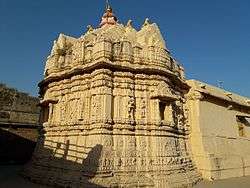 Brahma Temple, built c. 1060 AD. | |
 Khedbrahma Location in Gujarat, India  Khedbrahma Khedbrahma (India) | |
| Coordinates: 24°1′42″N 73°2′29″E / 24.02833°N 73.04139°ECoordinates: 24°1′42″N 73°2′29″E / 24.02833°N 73.04139°E | |
| Country |
|
| State | Gujarat |
| District | Sabarkantha district |
| Named for | Brahma |
| Government | |
| • Body | Nagar Palika |
| Elevation | 202 m (663 ft) |
| Population (2011) | |
| • Total | 25,001 |
| Languages | |
| • Official | Gujarati, Hindi |
| Time zone | UTC+5:30 (IST) |
| PIN | 383255 |
| Area code(s) | +91 2775 |
| Vehicle registration | starting with GJ 9 |
| Sex ratio | 1000/916 ♂/♀ |
Khedbrahma (![]()
Etymology
Brahmakshetra Mahatmaya mentions that that Brahma had established the town so the region was known as Brahmakshetra, the land of Brahma. He ploughed the land here and a river had flown out of it which was later known as Harnav, a corruption of Hiranyaganga which was named after Hiranyagarbh, another name of Brahma.[1][2][3] According to the inscription (Samvat 1256) in Aditi stepwell; the place was known as Brahmapur in Sat Yuga (era), Agnikhet in Treta Yuga, Hiranyapur in Dwapar Yuga and Tulakhet in Kali Yuga.[4][3] Brahmanotpattimartand mentions that the place was known as Brahmapur in Sat Yuga, Tryambakpur in Treta and Dwapar Yuga and Brahmakhetak in Kali Yuga.[1]
History

Brahmakshetra Mahatmaya (written after 10th century), the jnati-purana of Khedaval Bhrahmins, is a chief source of the mythological history of the region. It has 18 chapters. It was translated in Gujarati from Sanskrit in 1938. Ganpatishankar Shastri wrote Puratan Brahmakshetra in 1938 which traces mythological and literary history of the region in his book which is chiefly based on Brahmakshetra Mahatmaya.[3][2][1] Mythological narratives describes that the place was associated with Brahma and Bhrigu. Bhrigu had done several yajna (sacrifices) here. The temple ruins of Shiva, Shakti and Surya outskirt of the town confirms it antiquity.[5] Brahmanotpattimartand mentions Brahmakhetak town in south of Mount Abu. It also mentions Hiranya river, confluence of two rivers and Brahma temple housing statues of Brahma and his two consorts.[1]
The 15" long, 10" wide and 4" thick bricks were used in foundations of old temples and houses. They had crude finger marks which was a practise of Gupta period.[5]
The Pankheshwar Mahadev temple was built in early 11th century which has statues of Shiva in one niche dated to this period. The Ambika temple was also built in early 11th century confirmed by the style of its phansana roof. The Brahma Temple was built in late 11th century[6] while the Brahma stepwell was built in the 14th century.[7] The inscription in Aditi stepwell is dated Samvat 1256 (c. 1200) which definitely proves historicity of the town. There are several old Jain temples in the region.[3] Dalpatram has noted that Gadhaiya coins of Gupta period were found during the rebuilding of Nilkanth Mahadev temple near Brahma stepwell in Samvat 1912.[3][5] Bhrigu Ashram and Kshirajamba temple are also of older origin. In 1930s, more than hundred Jain images buried in ground were exposed by rain which were later moved to Digambar Jain temple on Idar hill. The practice of burial of images were meant to protect them during raids. These images belonged to 12th century.[5]
The region was under Bhil king of Tarsang who was defeated by Parmara of Malwa. Later it was under Chaulukya dynasty of Patan. The region was later ruled by Parihar Rajputs and came under sway of Rao of Idar State in 13th century. Rana Meghaji came to power in Samvat 1474 who repaired the Brahma temple.[3][1]
In past, the fair was held in February which used to draw large number of pilgrims and traders from Gujarat and Rajasthan. The Kathiawar traders used to raise booths on the south bank of the Harnav river and deal in opium, cloth, copperware, jewelry, grocery, and horses. The fair used to last for fifteen days. Goods worth a lakh were sold. The fair lost its importance from the time of Rao Kalyanmal (about 1630), when the Idar State fell a prey to rebellion and disorder.[8] Juvansinhji of Idar restarted the fair in Samvat 1917. In Samvat 1936, Kesharisinhji of Idar got Ambika temple repaired. In Samvat 1947, Gilabchand Manukchand of Vadali took a Sangh (procession) to Ambika temple and built rest house for pilgrims at cost of ₹ 2600. In 1920, Daulatsinhji of Idar State order to give land surrounding the Ambika temple to the temple authorities. Between Samvat 1978 and 1987, thirteen rest houses for pilgrims were built near the temples by various donors. Himmatsinhji of Idar had built a hanging bridge on the Harnav river.[3] The bridge was replaced by concrete bridge in 1959 and was expanded in 2017 at the cost of ₹ 34 crore.[9]
During the British period, Khedbrahma was under Idar State which was under Mahi Kantha Agency until 1933 when it was included in Sabar Kantha Agency. Sabar Kantha Agency was merged with Eastern Kathiawar Agency on 1 September 1943 which was subsequently merged in Western India States Agency in 1944 followed by Baroda, Western India and Gujarat States Agency (BWIGSA) in 1947. After independence of India in 1947, BWIGSA was merged in Bombay State and Khedbrahma fell under Sabarkantha district. In 1960, Bombay State was later divided along linguistic lines in Gujarat and Maharashtra. Sabarkantha became part of Gujarat. Khedbrahma is headquarter of Khedbrahma Taluka (sub-district).
Geography
The confluence of three small rivers (Triveni Sangam); namely Hiranyakshi, Bhimakshi and Kamakshi; is located here.[10] These rivers are also known as Hiranyaganga, Bhimashankari and Kosambi respectively.[3][5] Harnav river is also referred as Hiranyaksh or Harnai river.[8][11] After the confluence, the river is known as Harnav which empties in reservoir of Dharoi dam built on Sabarmati river down stream. Harnav river divides the town in north and south parts.[11][12]
Climate
Khedbrahma has a tropical climate. According to Köppen–Geiger climate classification system, this climate is classified as Tropical savanna climate (Aw). The average annual temperature is 26.5 °C. Average precipitation is 843 mm.[13]
| Climate data for Khedbrahma (1982-2012) | |||||||||||||
|---|---|---|---|---|---|---|---|---|---|---|---|---|---|
| Month | Jan | Feb | Mar | Apr | May | Jun | Jul | Aug | Sep | Oct | Nov | Dec | Year |
| Average high °C (°F) | 26.9 (80.4) |
30.4 (86.7) |
34.5 (94.1) |
38.4 (101.1) |
40.4 (104.7) |
37.7 (99.9) |
32.3 (90.1) |
30.9 (87.6) |
32.2 (90) |
34.5 (94.1) |
31.9 (89.4) |
28.7 (83.7) |
33.2 (91.8) |
| Daily mean °C (°F) | 18.8 (65.8) |
21.7 (71.1) |
26.1 (79) |
30.4 (86.7) |
33.4 (92.1) |
32.3 (90.1) |
28.7 (83.7) |
27.5 (81.5) |
27.9 (82.2) |
27.4 (81.3) |
23.2 (73.8) |
20.1 (68.2) |
26.5 (79.6) |
| Average low °C (°F) | 10.8 (51.4) |
13.0 (55.4) |
17.8 (64) |
22.5 (72.5) |
26.4 (79.5) |
26.9 (80.4) |
25.2 (77.4) |
24.2 (75.6) |
23.6 (74.5) |
20.3 (68.5) |
14.5 (58.1) |
11.5 (52.7) |
19.7 (67.5) |
| Average precipitation mm (inches) | 3 (0.12) |
0 (0) |
1 (0.04) |
1 (0.04) |
2 (0.08) |
73 (2.87) |
321 (12.64) |
257 (10.12) |
165 (6.5) |
15 (0.59) |
3 (0.12) |
2 (0.08) |
843 (33.2) |
| Source: Climate-Data.org (altitude: 207m)[13] | |||||||||||||
Demographics
According to 2011 Census of India, Khedbrahma municipality had a population of 25,001. Males constitute 52% of the population and females 48%. Khedbrahma has an average literacy rate of 67%, higher than the national average of 59.5%: male literacy is 73%, and female literacy is 56%. In Khedbrahma, 13% of the population is under 6 years of age.[14]
Civic administration
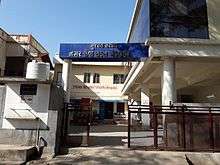
Khedbrahma has a Nagar Palika (municipality) and is Taluka headquarter. The municipality was established on 15 April 1994. There are 9 wards and 27 seats in municipality. There are 15 seats for reserved categories and 12 seats for unreserved categories.[15] Khedbrahma constituency is represented in Gujarat Legislative Assembly by one elected member.
Places of interest
Brahma temple
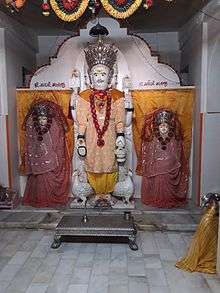

Khedbrahma has a temple dedicated to Brahma which is rarely seen in India, only second to Pushkar. It was built in third quarter of the 11th century during reign of Chaulukya king Karna.[16][6] This east facing temple is built of white sandstone and cement-covered bricks. It is fifty-seven feet long, thirty broad, and thirty-six high. The sanctum is 32 feet wide which is navaratha in anga and hastangula in plan and is of fully decorated class. Its pitha (base), the vedibandha and the mandovara (middle part of the wall) is resemble to the temple at Sunak. The spire, mandapa (dome) and doorway must have been destroyed which are rebuilt later in bricks and mortar. The lower part of main shrine is intact and is filled with images of gods, goddesses and apsaras. These images in jangha portion are poorly retouched. The chauri-barers on nandika are elegantly carved which are common in 11th century temples. The phansana roof resembles Vimala Vasahi temple and is crowned with a ghanta. There are images of Brahma in the niches on the three sides. The interior is devoid of any ornamental carving. The image of four faced standing Brahma is 1.8 m (5' 6") high and has two consorts on each side, Gayatri and Savitri. The image seems later installation or the older image plaster with cement to merge broken parts.[8][10][12][3][5][6]
Brahma stepwell
There is a stepwell, situated opposite the Brahma temple, known as Brahma Vav. It is built with grey granite stone. It is constructed in east-west direction; the entrance is in the east and the well is in the west. It is 38.10 metres long; 30 metres of stepped corridor and the well of 8.10 metre diameter. The stepwell becomes narrower as one goes downwards and to the well. It has four kuta (pavilion-towers) where fourth is attached to the well. The breadth is 8.50 metres (including parapet wall) and 6.60 metres (without parapet wall) at the entrance which decreases to 5.4 metres in second kuta and 3.90 metres in the third kuta. It had row of miniature shrines as an ornamentation in the wall of shaft of the stepwell which suggests it was built in 14th century. There is no inscription in the stepwell to ascertain its age. They resemble temple spires and has niches. It has 27 niches without any idols now. It is now in despair due to lack of maintenance.[17][4] There are some paliya (hero stone) dedicated to Dhabi gatekeepers of the village who were died fighting Maharaja Shivsinhji of Idar around Samvat 1800. The inscriptions on them are worn out.[3]
Aditi stepwell
Other historical stepwell, Aditi Vav is located on the north to the Brahma Vav on the way to Ambika temple. It was also known as Vikram Vav. An inscription dated Vaishakh Vad 1, Samvat 1256, Monday is present in the stepwell.[7][18] The inscription states following: The stepwell was built by Vikram of Talukhet (former name of town) who was son of Nagshri and Someshwar. Nagshri was daughter of Vasudev who was in turn son of Vaman who were Brahmin of Shandilya Gotra and had done several sacrifices. Someshwar's grandfather's name was who was in turn son of Surdev who were Brahmins of Kaushik Gotra of Vishwamitra Kula. The inscription was written by local Brahmin Sarvadev and the stepwell was constructed under the architect, Shamal who was son of Devdhar. The inscription starts with respect to Ganesha, Saraswati, Brahman and Brahma followed by names of the town in each Yuga (era).[3]
The stepwell is considered sacred by Humad Digambara Jains and Khedaval Brahmins who worship their patron deities in the stepwell.[19][3]
Ambika temple
Situated in north-east of the town, the Ambika temple was originally built in the early 11th century and renovated many time subsequently.[16] The older parts of the modern temple belong to the 17th century.[5] The temple is simple rectangular chamber with mukhamandapa in front. The base has an unusually thick jadyakumbha, a karnika and a plain pattika. It is followed by a vedibandha and a plain mandovara relieved by three niches, now empty. The temple is roofed by phansana topped by three ghanatas in a row, the form only seen in 11th century. The mukhamandapa has usual moulding of mattavarana.[6] The square of temple was known as Chachar Chowk. The temple is north-facing. The older idols in the temple complex include Ganesha idol on the entrance and Hanuman and Kal Bhairava idols. Of Brahmani, Sarasvati, Tripurasundari idols; the first two were originally found during excavation for construction of the main entrance or the rest house.[3] Every year many pilgrims come to Ambika temple especially during September–October due to Bhadarvi Purnima festival. It is also known as Nana Ambaji Temple.[4] There is a fair during Kartik Purnima (on full moon day of November–December) here. Pushya Purnima (on full moon day of February–March) is important because it is considered as a foundation day (Pragatya Divas) of the temple.[20][21] The temple is also known as Nana Ambaji.[4]
Bhrigurishi Ashram
There is also the Bhrigurishi ashram and a Bhrigunath Mahadev temple which is associated with folklores and Puranic stories. It is located in southeast of the town, on the south bank of the river and near the hillock.[5]
According to the Brahmakshetra Mahatmaya, the temple was built by Bhrigu, Brahma's son who was once sent by the seers, rishi, to find out who was the noblest of the Hindu trinity. Insulting Brahma and Rudra, they got angry and threatened to punish him. Seeking out Vishnu, Bhrigu was bold enough to place his foot on the god's chest. Instead of resenting, the kindly god asked the seer's pardon for the hardness of his breast. Bhrigu returned and praised Vishnu as the noblest of the gods. To wipe out the sin of insulting the gods, Bhrigu came to Brahma Kshetra, bathed in the Hiranyaksh, made his hermitage the seat of a Shiva, and performed such rigid austerities, that Shiva was pleased and freed him from his sin.[8][3]
Kshirjamba Mahalaxmi temple
The temple dedicated to Kshirjamba or Kshetramba is located on the hill near the Bhrigurishi Ashram.[5]
According to the Brahmakshetra Mahatmaya, this place owes its sanctity to a desire of Brahma to free himself from impurity. Vishnu, whom he consulted as to the means, advised him to perform a sacrifice at some holy spot in Bharatkhand in the Jambudvipa, and get learned Brahmin to officiate for him. Under Brahma's orders, Vishwakarma built a city on the right bank of the Sabarmati south of mount Abu, six miles (4 kos) round. It had golden ramparts and twenty-four gates and through it flowed the river Hiranyaksh, the modern Harnav. He then created 9000 Brahmans to officiate at the sacrifice. And, when the sacrifice was over, and the impurity removed, to maintain his Brahmins, he created 18,000 Vaishyas and gave them Kshirja as their family goddess. Before withdrawing from the world, he let the Brahmins dedicate a shrine to him, and place in it his four-faced image.[8]
Pankhanath Mahadev temple
Near the confluence of rivers, on the north bank opposite the Bhrigurishi Ashram, there is an old Pankhanath or Pankheshwar or Pankshindra Mahadev temple dedicated to Shiva. It is west-facing plain simple temple which is restored several times. In the back-niche of mandovara of temple, there is a figure of Nataraja (Shivatandav) with eight hands which helps in deciding the dating of the temple.[10][7] There is also one more Shiva figure in other form. The temple belongs to c. 11th century, built during reign of Bhima I of Chaulukya dynasty, contemporary of Sun Temple, Modhera.[7][6] In the sanctum, there is a small protuberance instead of an elaborate lingam which is considered swayambhu (self-existent) by the devotees.[5]
According to the legend mentioned in Brahmakshetra Mahatmaya, the serpent king Pingal Nag had enmity towards the Garuda. He had taken a form of Brahmin to escape from the Garuda and hid in Brahmakshetra. He exposed his true form to his Brahmin wife on occasion of Nag Panchami. The Garuda came to know and there a battle between them. The wing of the Garuda was broken off in the battle and the temple was erected at the place of the battle to commemorate it and named Pankhanath.[5][1]
Other temples
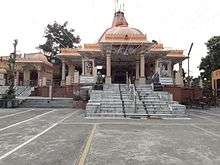
Hatakeshwar Hanuman temple located in old town is considered old. Near the Brahma stepwell, there is a Nilkanth Mahadev temple. There is an inscription dated Samvat 1912 about renovation of earlier temple.[3] Kashi Vishvanath Mahadev temples is situated on the south bank of the river which are popular locally. Mahavira Jain temple, situated in northern part of town, is almost 500 years old. The central catechu coloured idol of Mahavira is 90 cm in height and in Padmasana position.[11][12][7][18]
Amenities
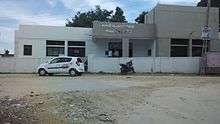

The town has a Government Taluka Library. There are two cinemas in the town including Aradhana. There is a 150-bed government referral hospital equipped with modern medical facilities which was opened in August 2015.[22]
Education
Khedbrahma has educational institutions teaching from primary level to graduation.
Higher education
- Arrdekta College of Engineering
- D. D. Thakar Arts and K. J. Patel Commerce College
- Krishi Polytechnic affiliated to Dantiwada Agriculture University
- Industrial Training Institute and Skill Certification Centre
Schools
- Ramjibapa KKP Kanya Vidyalaya
- Jyoti High School
- Sheth Keshavji Thakarsinh High School
- Chanchalba Government Primary School
- Asiana English School
- Gravity School
Transportation
Khedbrahma is connected to all major towns of Sabarkantha district by State Highway No. 9. There is a bus-station of Gujarat State Road Transport Corporation connecting all major cities of Gujarat. There is a railway station. As of 2017, the rail service is stopped for two and half years due to ongoing work of gauge conversion.[23]
References
- 1 2 3 4 5 6 Raval, Deepak (August 1994). Darji, Pravin, ed. "બ્રહ્મક્ષેત્રથી ખેડબ્રહ્મા" [Brahmakshetra To Khedbrahma]. Shabdasrishti. Gandhinagar: Gujarat Sahitya Akademi. 11 (8): 38–45.
- 1 2 Patel, Bipinkumar Hemrajbhai (2015). 2. ગુજરાતના સ્થળ-જ્ઞાતિ-પુરાણો: સમીક્ષાત્મક પરિચય [2. Place and Caste Puranas of Gujarat: A Critical Introduction]. પ્રમુખ પુરાણોમાં ગુજરાત દર્શન: સમીક્ષાત્મક અભ્યાસ [Glimpses of Gujarat in the Principal Puranas: A Critical Study] (PDF) (PhD) (in Gujarati). Rajkot: Saurashtra University. pp. 91–92. hdl:10603/126451. Retrieved 2017-08-19.
- 1 2 3 4 5 6 7 8 9 10 11 12 13 14 15 Shastri, Ganpatishankar (1935). Puratan Brahma Kshetra Prachin Arvachin Itihas [Ancient Brahma Kshetra: Ancient and Modern History] (in Gujarati). Idar: Idar State. pp. 3, 7–11, 15, 20, 54, 56–59, 111–157, 167–168.
- 1 2 3 4 Anjali H. Desai (2007). India Guide Gujarat. India Guide Publications. p. 191. ISBN 978-0-9789517-0-2.
- 1 2 3 4 5 6 7 8 9 10 11 Inamdar, P A (1936). Some Archaeological Finds In The Idar State. Idar: Department of Archaeology, Idar State. pp. 12–17.
- 1 2 3 4 5 Dhaky, Madhusudan A. (1961). Deva, Krishna, ed. "The Chronology of the Solanki Temples of Gujarat". Journal of the Madhya Pradesh Itihas Parishad. Bhopal: Madhya Pradesh Itihas Parishad. 3: 34, 76–77.
- 1 2 3 4 5 Rajyagor, S. B. (ed.). Gujarat State Gazetteers: Sabarkantha. Directorate of Government Print., Stationery and Publications, Gujarat State, 1974. pp. 74, 88, 91, 172. Retrieved 1 October 2012.
- 1 2 3 4 5 Gazetteer of the Bombay Presidency: Cutch, Pálanpur, and Mahi Kántha. Government Central Press. 1880. pp. 437–438.

- ↑ "હરણાવ નદી ઉપર નવા પુલનું નિર્માણ પૂર્ણ થયા બાદ પદયાત્રીઓને સરળતા મળશે" [New bridge on Harnav River will be helpful to pilgrims after completion]. Gujarat Samachar. 2015. Archived from the original on 29 August 2017. Retrieved 2017-08-29.
- 1 2 3 Sompura, Kantilal F. (1968). The Structural Temples of Gujarat, Upto 1600 A.D. Gujarat University. pp. 172–173.
- 1 2 3 Manohar Sajnani (2001). Encyclopaedia of Tourism Resources in India. Gyan Publishing House. pp. 110–111. ISBN 978-81-7835-018-9.
- 1 2 3 "Khedbrahma Taluka Official Govt. Website". Retrieved 1 October 2012.
- 1 2 "Climate: Khedbrahma – Climate graph, Temperature graph, Climate table". Climate-Data.org. Retrieved 28 March 2017.
- ↑ "Census of India 2011 - Khedbrahma (M)(802466)". Census of India, Office of the Registrar General & Census Commissioner, India under Ministry of Home Affairs, Government of India. Archived from the original on 19 August 2017. Retrieved 19 August 2017.
- ↑ "State Election Commission, Gujarat Official Website". Retrieved 1 October 2012.
- 1 2 Pramod Chandra (1975). Studies in Indian Temple Architecture: Papers Presented at a Seminar Held in Varanasi, 1967. American Institute of Indian Studies.
- ↑ Jutta Jain-Neubauer (1981). The Stepwells of Gujarat: In Art-historical Perspective. Abhinav Publications. p. 53. ISBN 978-0-391-02284-3.
- 1 2 Teerth Darshan. Shree Jain Prarthana Mandir Trust (Regd.). 2002. p. 520.
- ↑ Shukla, Rakesh (24 June 2014). "ક્યારેક લોકોની તરસ છિપાવતા હતા ગુજરાતના આ જળ મંદિરો-ખેડબ્રહ્માની વાવ". gujarati.oneindia.com (in Gujarati). Retrieved 20 November 2016.
- ↑ Dr. Krishna Gopal; Phal S. Girota (2003). Fairs and Festivals of India: Chhattisgarh, Dadra and Nagar Haveli, Daman and Diu, Goa, Gujarat, Madhya Pradesh, Maharashtra. Gyan Pub. House. pp. 106, 117, 118.
- ↑ "ખેડબ્રહ્મામાં મા અંબાના દર્શન માટે માનવ મહેરામણ ઊમટ્યો" [People flocked to Khedbrahma for glimpse of Goddess Amba]. Divya Bhaskar (in Gujarati). 5 April 2015. Retrieved 1 December 2016.
- ↑ DeshGujarat (2015-08-16). "Gujarat CM dedicates 150-bed govt hospital in tribal Khedbrahma". DeshGujarat. Retrieved 2015-08-17.
- ↑ "રેલ્વે લાઇનનું બ્રોડગેજમાં રૃપાંતરથી આજથી તલોદ-ખેડબ્રહ્મા તરફની ટ્રેનો બંધ". Gujarat Samachar (in Gujarati). 1 January 2017. Archived from the original on 24 January 2017. Retrieved 24 January 2017.
| Wikimedia Commons has media related to Khedbrahma. |